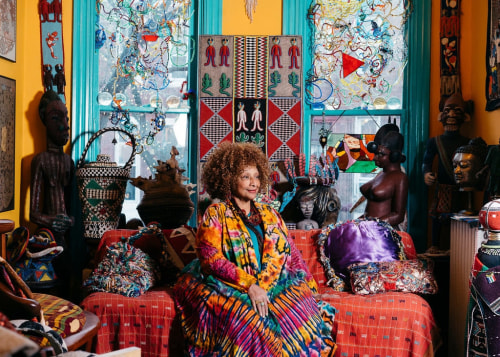
Joyce J. Scott, Photo by Justin T. Gellerson for The New York Times.
Why Baltimore Persists as a Cultural Beacon
By Andrew Martin
March 22, 2019
The city (population 600,000) has produced an eclectic variety of artists, including John Waters, Joyce J. Scott, David Simon and Abdu Ali.
POLITICS, AND PARTICULARLY the city’s cruel racial politics, both recent and past, are never far from the surface in discussions about Baltimore today. Black communities were the victims of residential redlining beginning in the 1930s, creating generations of wealth disparity and inadequate services. In April 1968, the city, like others across the country, boiled over into violent unrest following the assassination of Martin Luther King Jr., leaving six people dead, about 700 injured and widespread damage to businesses and property. Over the following decades, white flight led to a significant population decline, with many businesses following the city’s middle-class residents to the suburbs. In 2015, Freddie Gray, a black man arrested for illegal knife possession, was gravely injured while in police custody and died a week later, setting off protests calling for the investigation and prosecution of the officers responsible. The protests immediately following Gray’s funeral became violent, resulting in nationally broadcast images of burned police cars and businesses. In the following months, the city saw a spike in homicides (the reasons for which remain disputed); over the following year, the officers involved in Gray’s apprehension and transportation were charged with crimes related to his death, but after the initial trials resulted in three acquittals, the charges against the remaining three officers were dropped. If it were ever possible to work and live as an artist in Baltimore while ignoring the city’s pervasive racial injustices, large and small, that time has long passed.
The sculptor Joyce J. Scott and the photographer Shan Wallace represent two generations of Baltimore visual artists, both committed to depicting the city’s African-American history and its present-day existence through their respective mediums. Scott, 70, creates beautiful, troubling sculpture and jewelry, which often incorporates delicate traditional beadwork and confronts the horrors of the country’s racial history: Her piece “Lynched Tree” (2011-15) is a large, amorphous sculpture that depicts a body hanging upside down by the legs from the ceiling, spilling chains, beads and bones onto the gallery floor below.